Nicaragua currency is the Nicaraguan córdoba, which is abbreviated as NIO. The córdoba has been the country’s official currency since 1912 and is used for all transactions within Nicaragua.
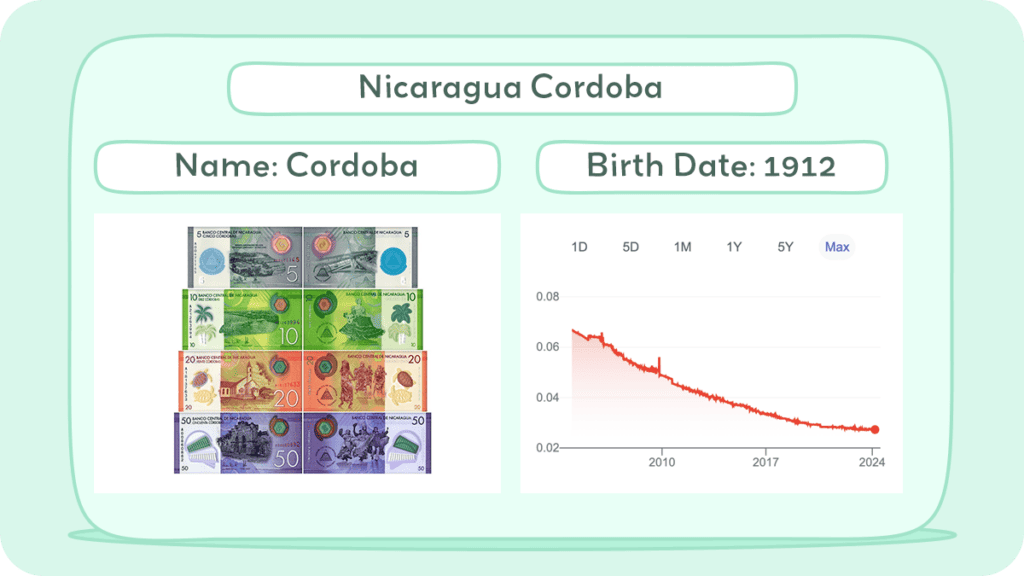
The Central Bank of Nicaragua (BCN), is responsible for regulating the country’s monetary policy and issuing new banknotes and coins. The current banknotes in circulation are in denominations of 10, 20, 50, 100, 200, 500, and 1,000 córdobas. The coins in circulation are in denominations of 5, 10, and 25 centavos, as well as 1 and 5 córdobas.
This article explores the Nicaraguan córdoba, the national currency of Nicaragua. It delves into the history of the córdoba, including its establishment and subsequent transformations, alongside interesting facts about the currency.
Historical Journey of Nicaragua Currency
Over the years, Nicaragua has had a diverse range of currencies. Before the arrival of the Spanish, the indigenous people used cocoa beans as currency. However, when the Spanish arrived in Nicaragua in 1502, they brought their coins, and Nicaraguans began using them to buy and sell goods.
Even after the country permanently gained independence from Spain in 1838, the country lacked a national currency. The first currency that was officially introduced in Nicaragua was the peso moneda corriente, which was circulated by the Central American Republic.
In 1912, the Nicaraguan government created the National Bank of Nicaragua (Banco Nacional de Nicaragua Incorporado) and introduced the first córdoba, which replaced the peso moneda corriente.
The córdoba was named after Francisco Hernández de Córdoba, a Spanish conquistador who founded the first permanent settlement at Grenada on Lake Nicaragua.
During the Somoza regime, the córdoba was pegged to the US dollar at a rate of 1:1. However, after the Sandinista government came to power in 1979, the currency was devalued to 10 córdobas per US dollar.
In the 1980s, Nicaragua experienced hyperinflation, and the córdoba lost its value rapidly. In response, the government introduced a new currency, the “new córdoba,” in 1991, which was equivalent to 1,000 old córdobas.
Today, the córdoba is the official currency of Nicaragua and is subdivided into 100 centavos. The current exchange rate is approximately 1 US dollar to 34 Nicaraguan córdobas.
History of Coins
In 1912, Nicaragua introduced its first series of córdoba coins in various denominations, utilizing materials like bronze for the lowest values, cupro-nickel for intermediate ones, and silver for the higher denominations.
Over time, the materials and denominations evolved in response to economic conditions and policy changes. By 1939, cupro-nickel replaced silver for certain coins, and by the 1980s, new designs featuring Augusto César Sandino were introduced, with materials ranging from aluminum to nickel-clad steel.
The second córdoba saw no coin issuance, but the third córdoba oro, reintroduced in 1991, brought about denominations in modern materials like chrome-plated steel, nickel-clad steel, and later, brass-plated steel, reflecting ongoing adjustments to inflation and economic needs.
Various series over the years have commemorated significant national themes, with the most recent 2022 series incorporating materials like stainless steel for durability and anti-counterfeiting measures, maintaining a focus on national symbols and landmarks.
This progression demonstrates Nicaragua’s adaptive approach to its currency’s physical representation amidst changing economic landscapes.
History of Bills
The history of Nicaraguan banknotes spans several periods, starting in 1912 when the National Bank of Nicaragua introduced a range of denominations, including innovative overprinted notes for smaller values.
By the 1930s and 1940s, further denominations were introduced, including high-value notes during periods of economic change. In 1962, the Central Bank took over issuance, marking a shift to more durable and secure forms of currency, including the replacement of some notes with coins.
The introduction of the second córdoba was exclusive to banknotes, adapting to economic conditions with a variety of denominations. The third córdoba, or córdoba oro, introduced in 1991, continued this evolution with new denominations and the gradual replacement of lower-value notes with coins.
Throughout these changes, Nicaraguan banknotes have featured prominent national figures and landmarks, evolving in design and security features to include modern polymer materials and advanced anti-counterfeiting measures.
The most recent series, introduced between 2015 and 2019, includes polymer notes for durability and security, reflecting Nicaragua’s rich cultural heritage and historical milestones, such as the commemoration of poet Rubén Darío, while also addressing practical needs for secure and convenient high-value transactions.
Inflation and Buying Power of Nicaragua Currency

If you’re planning a trip to Nicaragua, it’s important to understand the current state of the country’s currency. The official currency of Nicaragua is the Nicaraguan córdoba (NIO).
As of February 2024, the inflation rate in Nicaragua is 5.79% Trading Economics. This means that the prices of goods and services are increasing at a rate of 5.79% per year, on average.
Inflation can have a significant impact on the buying power of the Nicaraguan córdoba. As the value of the currency decreases, it takes more córdobas to purchase the same amount of goods and services.
For example, if a cup of coffee costs 20 córdobas today and the inflation rate is 5.79%, next year that same cup of coffee would cost 21.16 córdobas.
To put this in perspective, let’s look at the historical inflation rate of the Nicaraguan córdoba. According to Inflation Calculator, the inflation rate in Nicaragua has averaged around 8.54% per year since 1970. This means that the buying power of the Nicaraguan córdoba has decreased significantly over time.
Despite the high inflation rate, the Nicaraguan córdoba remains a relatively stable currency. According to FocusEconomics, the exchange rate between the Nicaraguan córdoba and the US dollar has remained relatively stable in recent years. However, it’s important to keep in mind that exchange rates can fluctuate and impact the value of your money when traveling.
Overall, it’s important to be aware of the current inflation rate and exchange rate when planning a trip to Nicaragua. By keeping an eye on these factors, you can make informed decisions about how to budget and spend your money while traveling.
Nicaraguan Cordoba
Between 2015 and 2017, Nicaragua released a new series of banknotes, approved by a resolution on March 26, 2014. These notes feature iconic Nicaraguan landmarks and cultural symbols on both their obverse and reverse sides.
The series includes denominations from C$5 to C$1,000, with most notes printed on polymer for enhanced durability and security, except for the initial C$500 and C$1,000 notes which were initially issued on paper.
C$5
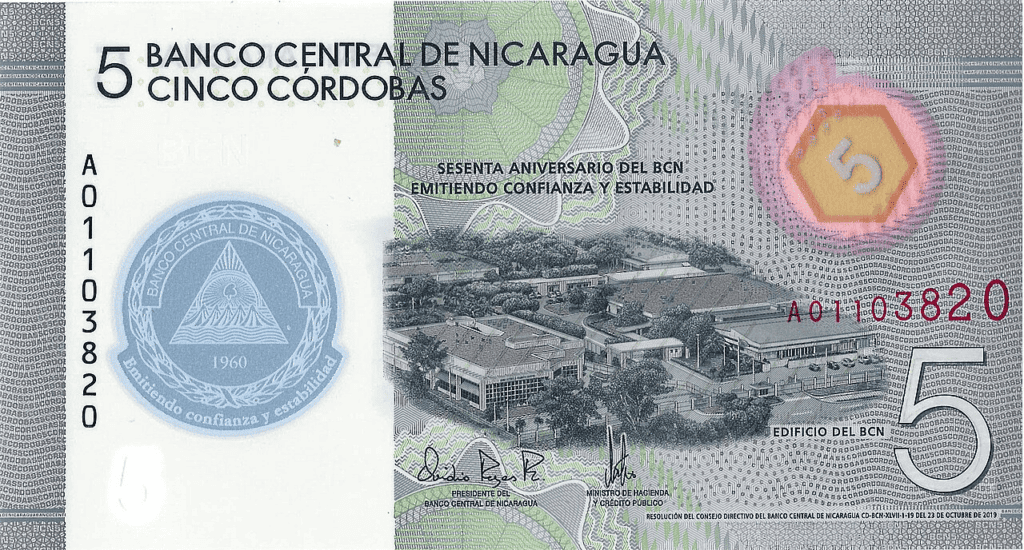
The C$5 note showcases the Nicaraguan central bank building and Las Piedrecitas overpass.
C$10
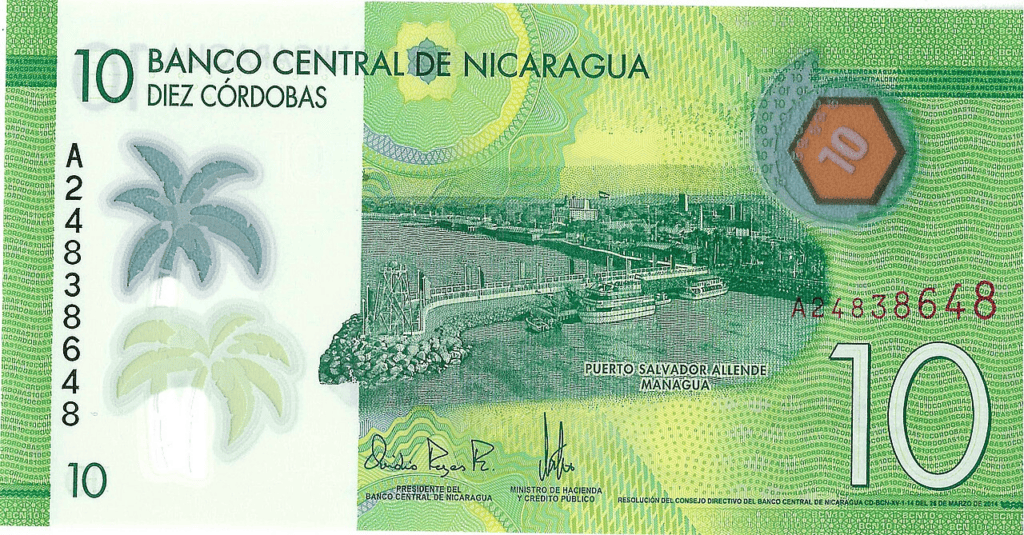
The C$10 note features Puerto Salvador Allende in Managua and La Vaquita, representing the Patron Saint festivities of Managua.
C$20
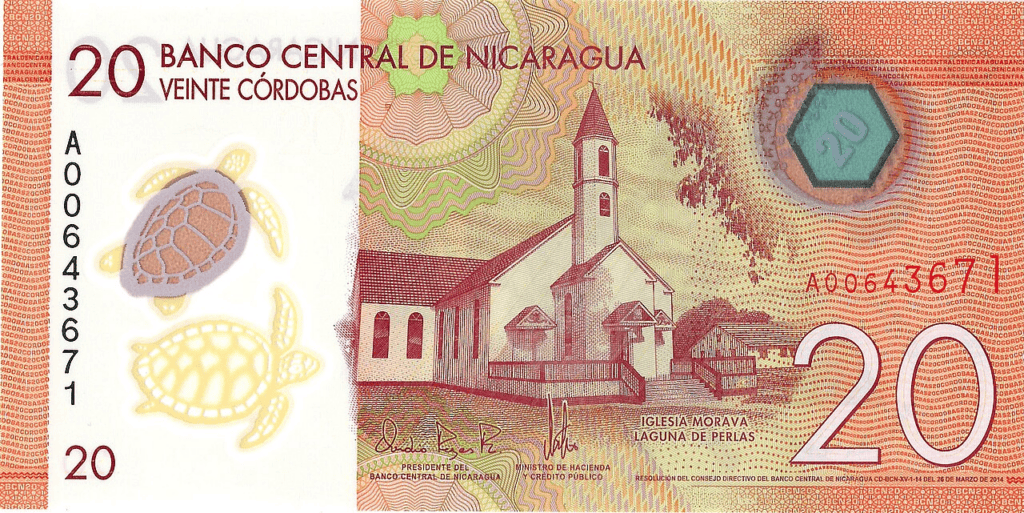
The C$20 note highlights the Moravian church in Laguna de Perlas and the Mayo Ya Festival.
C$50
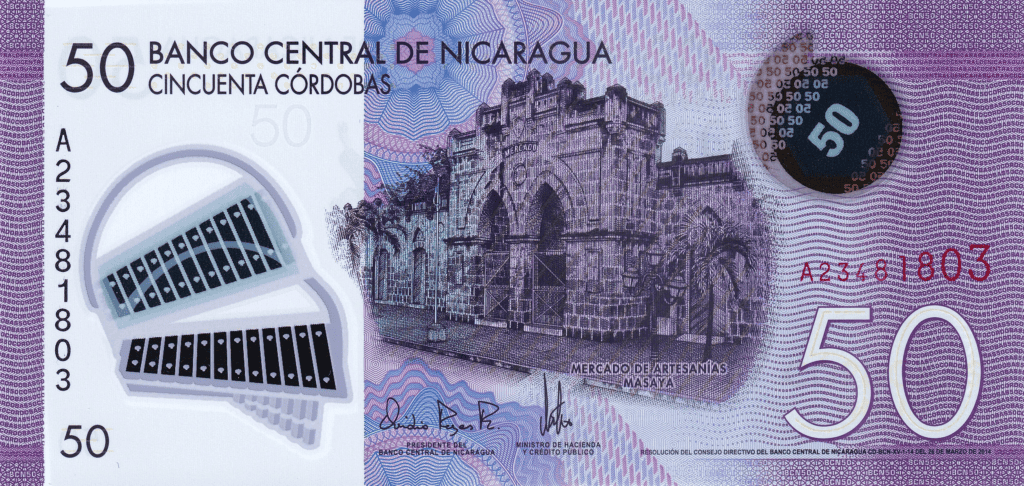
The C$50 note depicts the Artisan Market in Masaya and a folkloristic ballet.
C$100
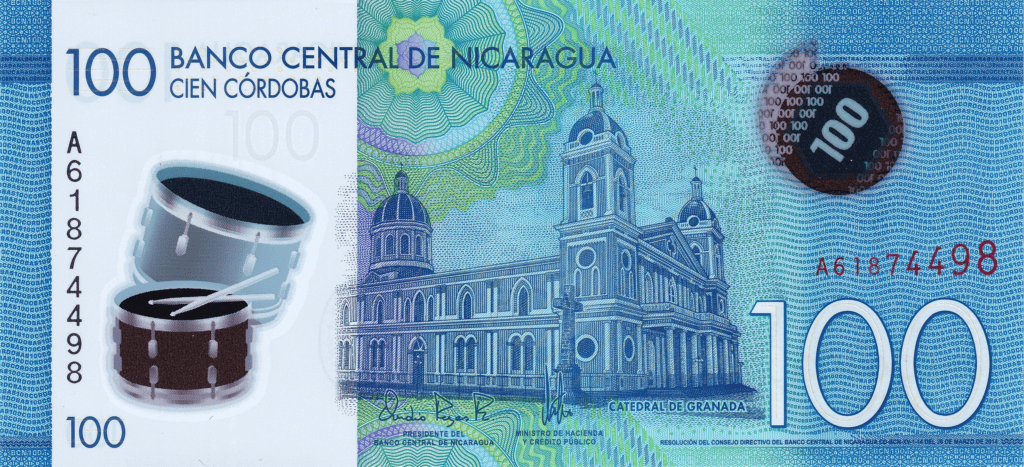
The C$100 note displays the Cathedral of Granada and a horse cart.
C$200
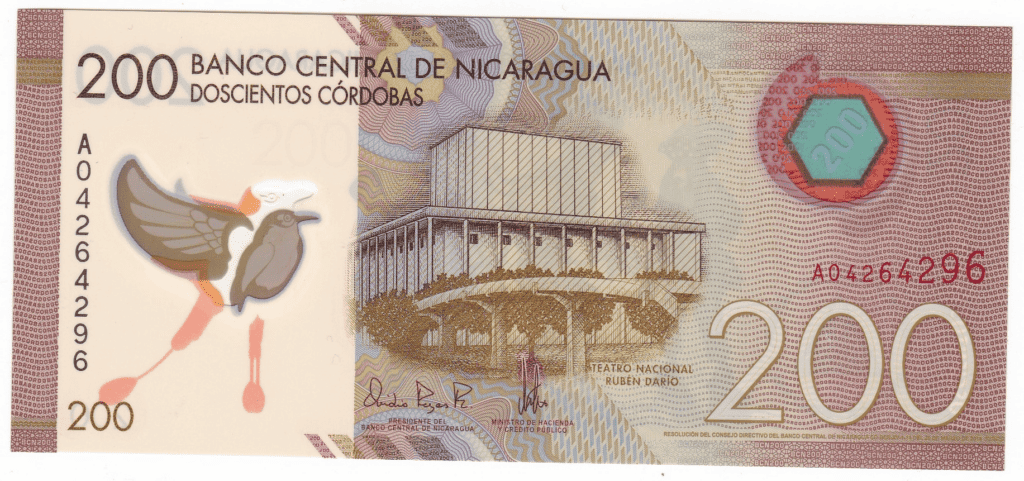
The C$200 note features the Rubén Darío National Theater in Managua and the El Güegüense comedy ballet.
C$500

The C$500 note, initially issued on paper and later in polymer, features the Cathedral of León and the Momotombo Volcano.
C$1,000

Lastly, the C$1,000 note, also initially issued on paper before a polymer version was released, showcases Hacienda San Jacinto, Tipitapa, and the Castle of the Immaculate Conception, Río San Juan, reflecting Nicaragua’s rich cultural heritage and natural beauty.
Currency Usage in Nicaragua
Nicaragua’s official currency is the Nicaraguan córdoba (NIO), which is divided into 100 centavos. The currency is abbreviated as C$ and is available in coins and banknotes.
The banknotes are available in denominations of C$10, C$20, C$50, C$100, C$200, and C$500. There are also coins available in denominations of C$0.10, C$0.25, C$0.50, C$1, and C$5.
Is USD accepted in Nicaragua?
Yes, the US dollar (USD) is widely accepted in Nicaragua, especially in tourist areas and major cities. Many businesses, including hotels, restaurants, and shops, accept USD as payment, and some even prefer it over the local currency.
However, it is important to note that you may receive change in córdoba, and the exchange rate may not always be in your favor.
It is recommended to carry both córdobas and USD when traveling to Nicaragua. ATMs are widely available, and most of them dispense both córdobas and USD. However, it is advisable to check with your bank about any foreign transaction fees or ATM withdrawal fees before traveling.
While the official currency of Nicaragua is the córdoba, USD is widely accepted in the country. It is recommended to carry both currencies and check with your bank about any fees before traveling.
Exchanging Currency in Nicaragua
If you plan to travel to Nicaragua, you will need to exchange your currency to the Nicaraguan córdoba (NIO). Here are some things you should know before exchanging currency in Nicaragua.
Where can I exchange Nicaragua currency?
You can exchange your currency at banks, exchange offices, and some hotels in Nicaragua. Banks usually offer the best exchange rates, but they may have limited hours of operation.
Exchange offices and hotels may have more flexible hours, but they may offer less favorable exchange rates. Be sure to compare exchange rates and fees before exchanging your currency.
What to know before exchanging currency in Nicaragua
- Bring cash in good condition: Banks and exchange offices in Nicaragua may not accept cash that is torn, damaged, or heavily marked. Make sure to bring bills that are in good condition.
- Bring US dollars: US dollars are widely accepted in Nicaragua, especially in tourist areas. You can exchange your US dollars for Nicaraguan córdobas at banks and exchange offices.
- Exchange in small amounts: It’s a good idea to exchange your currency in small amounts, especially if you are exchanging at exchange offices or hotels. This way, you can avoid losing a lot of money if the exchange rate is unfavorable.
- Beware of scams: Be cautious when exchanging your currency in Nicaragua. Some exchange offices may try to scam you by offering very low exchange rates or by giving you counterfeit bills. Make sure to exchange your currency at reputable banks or exchange offices.
By following these tips, you can exchange your currency safely and efficiently in Nicaragua.
Choosing Between USD and Nicaragua currency
If you are planning a trip to Nicaragua, you might be wondering whether to use USD or the local currency, Nicaraguan córdoba. Here are some factors to consider when making your decision:
Exchange rate
The exchange rate between USD and Nicaraguan córdoba fluctuates daily. The córdoba is a relatively stable currency. While US dollars are widely accepted in many parts of Nicaragua, it’s still a good idea to have some córdobas on hand for smaller purchases and transactions.
You can exchange your dollars for córdobas at banks, exchange bureaus, and ATMs throughout the country. It’s important to keep an eye on the exchange rate to ensure you are getting a fair deal.
Convenience
Many businesses in Nicaragua accept both USD and Nicaraguan córdoba. However, smaller businesses and vendors may only accept local currency. It’s a good idea to carry some cash in both currencies to ensure you can make purchases wherever you go.
Fees
When exchanging currency, be aware of fees that may be charged by banks or currency exchange services. Some businesses may also charge a fee for using a credit card. It’s a good idea to research fees and exchange rates before you travel to ensure you are getting the best deal.
Tips
When paying with USD, be aware that you may receive change in Nicaraguan córdoba. It’s a good idea to carry small bills and coins in both currencies to make transactions easier. Additionally, it’s customary to tip in Nicaraguan córdoba rather than USD.
Overall, whether to use USD or Nicaraguan córdoba depends on your personal preferences and travel plans. It’s a good idea to carry some cash in both currencies and research exchange rates and fees before you travel.
Cost of Living in Nicaragua
If you are planning to move to Nicaragua, it’s essential to understand the cost of living in the country. Nicaragua is one of the most affordable countries in Central America, with a low cost of living compared to the United States and other Western countries.
The cost of living in Nicaragua varies depending on your lifestyle, location, and family size. According to Expatistan, a family of four can expect to spend around $2,151 per month, while a single person can expect to spend around $904 per month.
These estimates include expenses such as housing, food, transportation, and entertainment. However, it’s essential to note that these estimates are based on data that may have some inconsistencies at the moment.
According to Numbeo, the cost of living in Nicaragua is, on average, 54.3% lower than in the United States. A family of four can expect to spend around $1,882.6 per month without rent, while a single person can expect to spend around $537.7 per month without rent. Rent in Nicaragua is, on average, 80.5% lower than in the United States.
If you plan on moving to Nicaragua, it’s essential to consider your lifestyle and location. According to The Nomad Hive, for a single person, the cost of living in Nicaragua can range between $600 to $1200 USD per month, depending on your lifestyle and location. If you plan on moving with your family, you will need a bit more, around $1500 to $2000 per month.
Overall, Nicaragua is an affordable country to live in, with a low cost of living compared to other Western countries. However, it’s essential to consider your lifestyle and location when estimating your monthly expenses.
Don’t Get Scammed Tips
When traveling to Nicaragua, it’s essential to be aware of the common scams and tricks that locals and street vendors use to take advantage of tourists. Here are some tips to help you avoid getting scammed:
- Be Careful When Exchanging Currency
Nicaragua’s official currency is the córdoba, and while it’s relatively easy to exchange foreign currency for córdobas, it’s important to be careful when doing so. Some street vendors may try to give you fake or counterfeit bills, so it’s best to exchange your money at a reputable bank or exchange house.
You can also use your debit or credit card to withdraw money from ATMs, but make sure to use ATMs located in safe and busy areas to avoid getting robbed.
- Avoid Street Vendors and Unlicensed Taxi Drivers
While street vendors in Nicaragua may seem friendly and eager to sell you their products, it’s best to avoid them altogether. Many of them sell counterfeit goods, and some may try to steal from you or charge you more than the actual price. It’s also best to avoid unlicensed taxi drivers, as they may overcharge you or take you to unsafe areas.
- Watch Out for Pickpockets
Pickpocketing is a common problem in Nicaragua, especially in crowded areas such as markets, bus stations, and tourist attractions. To avoid getting your wallet or phone stolen, keep your belongings close to you at all times and avoid carrying too much cash or valuables with you. You can also use a money belt or a cross-body bag to keep your belongings safe.
By following these simple tips, you can enjoy a safe and hassle-free trip to Nicaragua without falling victim to common scams and tricks.

